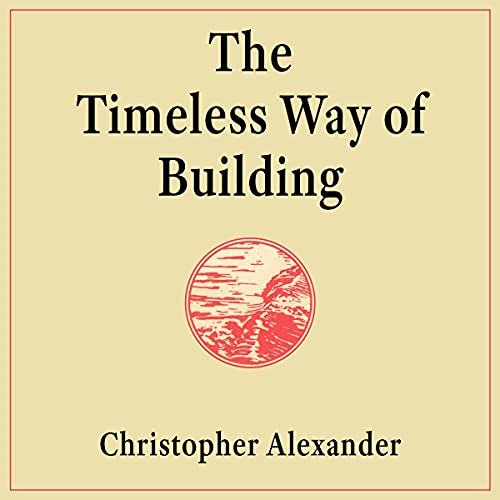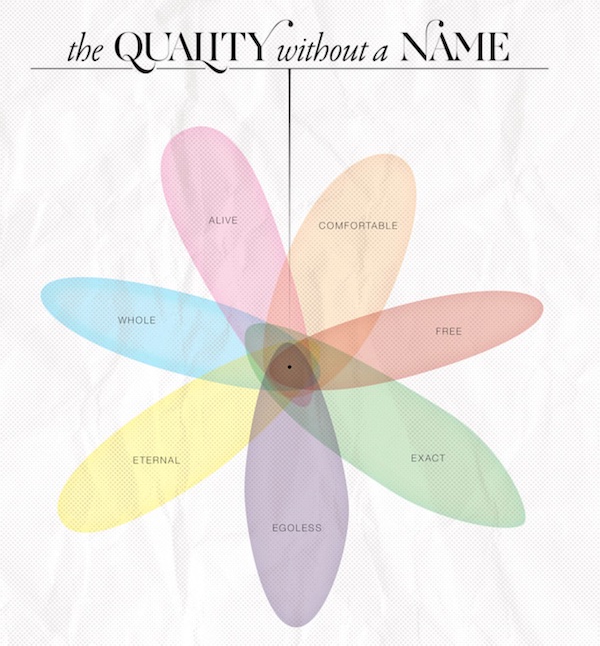The Timeless Way of Building

The built world is defined by a small number of patterns, which keep repeating over and over and over again. The patterns are deep and mostly relational. This applies at all scales in human construction: to American cities, Gothic cathedrals, Paris, Chinese kitchens, doors, and so on.
These patterns can be codified into a pattern language. And just like a great writer or orator has an intuitive grasp of human language, a great builder can and should strive to attain an intuitive grasp of his pattern language.
But just because you have a pattern language does not make it good. A concrete jungle is also governed by a pattern language. Alexander strives to capture a collection of patterns that create a microcosm that has "The Quality Without a Name", which he defines via negativa (see Negative theology and via negativa). Here's a quick summary:

Subsequent books in the series present lists of specific patterns at various scale levels (eg. town, building, substructure) that Alexander wholeheartedly endorses.
Tired: things I didn't love 😫
- Stuffy tone
- Exacerbated by the narrator's proper English accent in the audio book.
- Dry prose. If I had a nickel for every "pattern of events" in some of those middle chapters...!
- Overly universalist
- The Quality Without A Name is supposed to span time and space. It's timeless, as per the title of the book, but this pomposity is the opposite of the egoless ideal.
- Alexander makes sweeping claims like whether a pattern language is alive or dead is necessarily objective.
- QWAN has a strong “you’ll know it when you see it” vibe. Alexander is really appealing to some imagined sense of universal taste.
- Opinionated and tending negative
- About architecture, including modern star architects, nature-inspired architects like Frank Lloyd Wright.
- About specialization in general
- About materials that tend to last forever like concrete and metal. They are inherently not alive.
Wired: things I loved 💗💗💗
- The specific patterns found in the second volume "A Pattern Language", especially pertaining to buildings. I'd never thought of many of them, and now find myself viewing buildings through this patterned lens.
- Every living thing is the product of a process. There is no way to creates a living thing by some direct process.
- Trying to define QWAN as an overlap of many attributes, where none of the attributes on its own adequately describe it. Reminds me of Negative theology and via negativa
- One of the attributes of QWAN is "Being Alive", which although vague is evocative. Design must be done with the idea of death. Nothing can be alive unless it can become dead (see Momento mori).
- Only about 5% of buildings are designed by architects. The vast majority are constructed by following relatively simple patterns and rules.
Inspired: threads to pull on ✨🧵✨
- It's difficult to describe what constitutes a rough circle. A precise circle is easy to quantify. It is the locus of points that are equidistant from a center. But naively defining a rough circle as some locus of connected points 5 to 6 cm away from a certain point might include zigzags, polygons, or other shapes that are totally not circle-like.
- How would I algorithmically generate a rough circle? Sounds like a fun side project or interview question.
- Alexander leans heavily on the environment as something that is critical for happiness. It does not come from within. I liked that he acknowledges that this is an untrendy claim to make, and explicitly defends his position. How much happiness comes from the self, and how much from the environment?
- What are the pattern languages for 1940-59 builds in Seattle? What about the 1910 eta craftsmen? How about new modern builds going up now?
- Can these design patterns be used to consider whether existing buildings are good? I am judging my house and my parents house from this vantage point.
- What are the buildings and building patterns I like most?
- In PYNY's house: great benches integrated into windowsills.
- I took notes on this too, see Design Pattern Languages for Single Family Homes.
- Can this be somehow adapted when considering what to look for in a new house? It's a bit like Marie Kondo's "do these underwear spark joy" question. Evocative but also silly.
- Alexander implores us to design without drawing plans. Keep the whole project plan in the mind as you conceive it to be maximally flexible. As you add new patterns to the design, the whole system may need to morph, so any representation other than that of the mind's eye is too inflexible. This seems too extreme, but also somehow appealing.